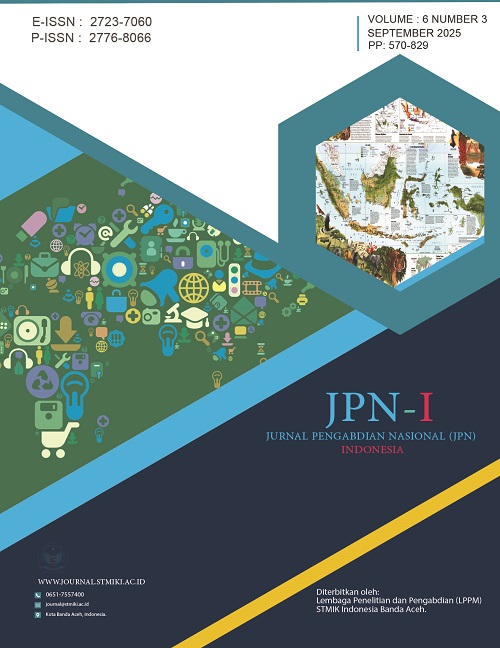Implementasi Anestesi Perioperatif Berbasis Artificial Intelligence (Studi Mixed Methods Exploratory di RS J. H. Awaloei)
Main Article Content
Abstract
Article Summary
Human resource and time constraints in perioperative anesthesia at J.H. Awaloei Hospital where anesthesiologist-to-patient ratio is 1:12 and a 4 to 6-hour pre-anesthesia window are associated with complications, surgical delays, and costs. This study assessed the impact of artificial intelligence (AI) on operational efficiency, clinical safety, and financial performance using a sequential exploratory mixed-methods design with in-depth interviews from 18 key informants, a staff survey (n=40), and a 20-case time-motion comparison of traditional versus AI-assisted workflows; 2023 hospital audits informed the baseline, and study activities ran from December 2024 to May 2025. Analyses used descriptive statistics and appropriate tests; costing adopted a hospital perspective with 2024 prices, chiefly inpatient accommodation. AI use was associated with an 86.2% reduction in assessment time, operating room utilization rising to 82–84%, a 30% increase in risk detection, 18–22% fewer complications, a 40% reduction in 30-day readmission, and projected annual savings. The results indicate improvements with potential to strengthen predictive risk governance and cost efficiency; broader, risk-adjusted evaluations are warranted to confirm generalizability.
Downloads
Article Details

This work is licensed under a Creative Commons Attribution-NonCommercial-ShareAlike 4.0 International License.
References
Amer, F., Hammoud, S., Khatatbeh, H., Lohner, S., Boncz, I., & Endrei, D. (2022). The deployment of balanced scorecard in health care organizations: is it beneficial? A systematic review. BMC health services research, 22(1), 65.
Ames, H., Glenton, C., & Lewin, S. (2019). Purposive sampling in a qualitative evidence synthesis: A worked example from a synthesis on parental perceptions of vaccination communication. BMC medical research methodology, 19(1), 26.
Bellini, V., Russo, M., Domenichetti, T., Panizzi, M., Allai, S., & Bignami, E. G. (2024). Artificial intelligence in operating room management. Journal of medical systems, 48(1), 19.
Betto, F., Sardi, A., Garengo, P., & Sorano, E. (2022). The evolution of balanced scorecard in healthcare: A systematic review of its design, implementation, use, and review. International journal of environmental research and public health, 19(16), 10291.
Braun, V., & Clarke, V. (2021). Thematic analysis: A practical guide.
Collins, G. S., Moons, K. G., Dhiman, P., Riley, R. D., Beam, A. L., Van Calster, B., ... & Logullo, P. (2024). TRIPOD+ AI statement: updated guidance for reporting clinical prediction models that use regression or machine learning methods. bmj, 385. https://doi.org/10.1136/bmj-2023-078378.
Guidance, W. H. O. (2021). Ethics and governance of artificial intelligence for health. World Health Organization.
Hassan, N., Slight, R., Morgan, G., Bates, D. W., Gallier, S., Sapey, E., & Slight, S. (2023). Road map for clinicians to develop and evaluate AI predictive models to inform clinical decision-making. BMJ Health & Care Informatics, 30(1), e100784. https://doi.org/10.1136/bmjhci-2023-100784.
Liu, X., Rivera, S. C., Moher, D., Calvert, M. J., Denniston, A. K., Ashrafian, H., ... & Yau, C. (2020). Reporting guidelines for clinical trial reports for interventions involving artificial intelligence: the CONSORT-AI extension. The Lancet Digital Health, 2(10), e537-e548.
McCradden, M. D., Joshi, S., Anderson, J. A., & London, A. J. (2023). A normative framework for artificial intelligence as a sociotechnical system in healthcare. Patterns, 4(11).
Rellum, S. R., Schuurmans, J., van der Ven, W. H., Eberl, S., Driessen, A. H., Vlaar, A. P., & Veelo, D. P. (2021). Machine learning methods for perioperative anesthetic management in cardiac surgery patients: a scoping review. Journal of thoracic disease, 13(12), 6976.
Rivera, S. C., Liu, X., Chan, A. W., Denniston, A. K., Calvert, M. J., Ashrafian, H., ... & Yau, C. (2020). Guidelines for clinical trial protocols for interventions involving artificial intelligence: the SPIRIT-AI extension. The Lancet Digital Health, 2(10), e549-e560.
Roppelt, J. S., Kanbach, D. K., & Kraus, S. (2024). Artificial intelligence in healthcare institutions: A systematic literature review on influencing factors. Technology in society, 76, 102443.
Taherdoost, H. (2022). What are different research approaches? Comprehensive review of qualitative, quantitative, and mixed method research, their applications, types, and limitations. Journal of Management Science & Engineering Research, 5(1), 53-63.
Tolley, E. E., Ulin, P. R., Mack, N., Robinson, E. T., & Succop, S. M. (2016). Qualitative methods in public health: a field guide for applied research. John Wiley & Sons.
Wang, Y., Gao, Y., Lu, M., & Liu, Y. (2020). Long-term functional prognosis of patients with aneurysmal subarachnoid hemorrhage treated with rehabilitation combined with hyperbaric oxygen: Case-series study. Medicine, 99(3), e18748.
Yoon, H. K., Yang, H. L., Jung, C. W., & Lee, H. C. (2022). Artificial intelligence in perioperative medicine: a narrative review. Korean journal of anesthesiology, 75(3), 202-215.

